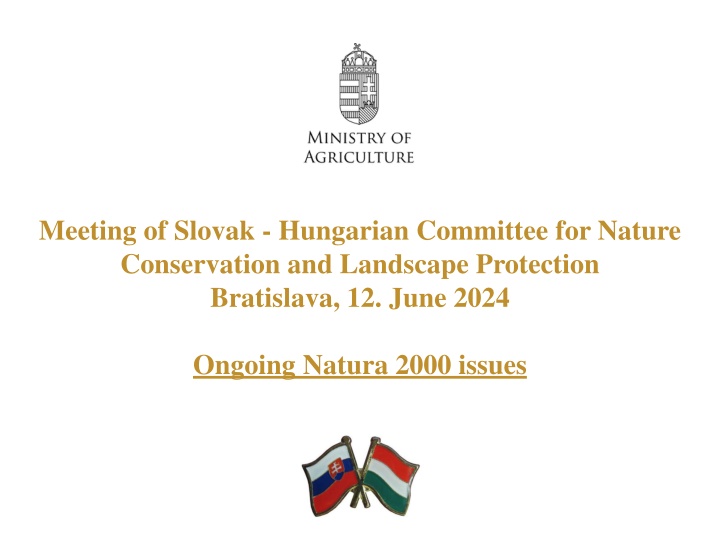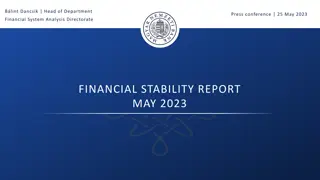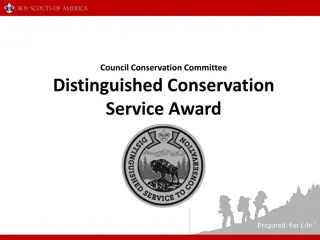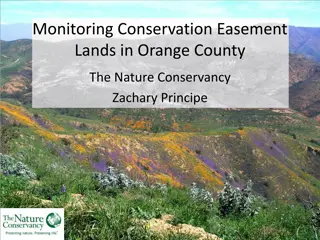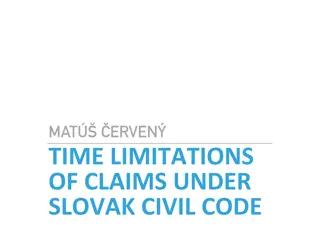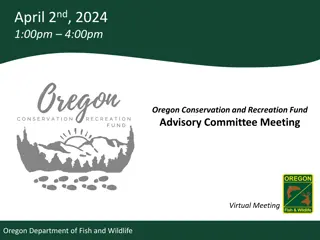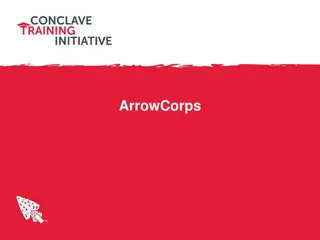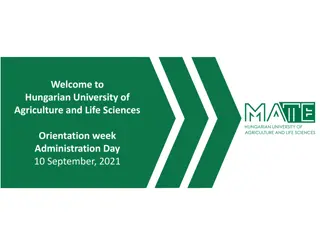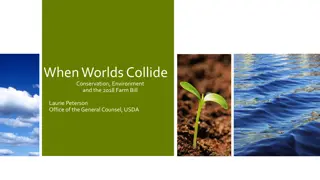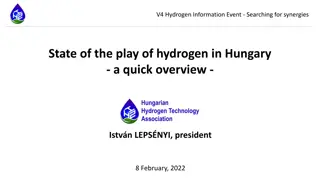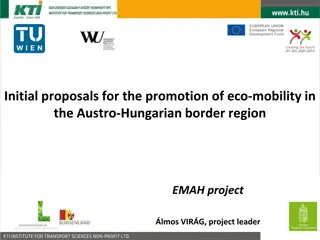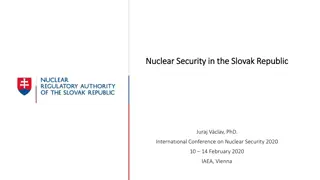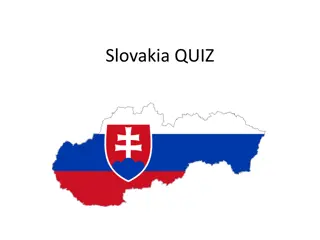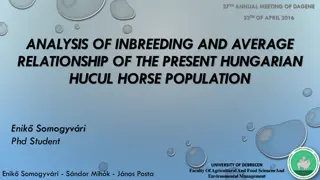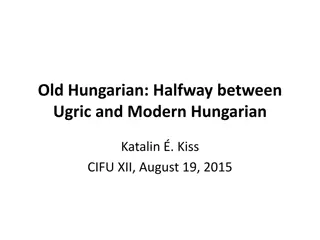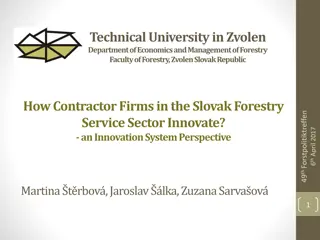Slovak-Hungarian Committee for Nature Conservation Meeting
The meeting of the Slovak-Hungarian Committee for Nature Conservation and Landscape Protection in Bratislava on 12 June 2024 will focus on ongoing Natura 2000 issues. Representatives will address critical conservation matters and discuss collaborative strategies for preserving the natural landscape. Key topics will include biodiversity protection, habitat management, and sustainable development practices. Participants aim to strengthen cross-border cooperation and enhance conservation efforts in the region.
Download Presentation

Please find below an Image/Link to download the presentation.
The content on the website is provided AS IS for your information and personal use only. It may not be sold, licensed, or shared on other websites without obtaining consent from the author.If you encounter any issues during the download, it is possible that the publisher has removed the file from their server.
You are allowed to download the files provided on this website for personal or commercial use, subject to the condition that they are used lawfully. All files are the property of their respective owners.
The content on the website is provided AS IS for your information and personal use only. It may not be sold, licensed, or shared on other websites without obtaining consent from the author.
E N D
Presentation Transcript
Meeting of Slovak - Hungarian Committee for Nature Conservation and Landscape Protection Bratislava, 12. June 2024 Ongoing Natura 2000 issues K ptal lat a k vetkez re: szlov k magyar z szl
Content Natura 2000 management plans Site Specific Conservation Objectives Standard Data Forms Reporting under Habitats and Bird Directives
Conservation measures and objectives in Hungary Natura 2000 management (maintenance) plans: detailed site specific conservation measures and general conservation objectives Preparation period: 2008-2023 Content: 60-700 pages SSCO documents: detailed Site Specific Conservation Objectives Preparation period: I. 2010-2011 II. 2020-2024 (supervision and rewriting based on COM guidance) Content: 15-400 pages
Natura 2000 management plans exist for all the 525 Natura 2000 sites (finished in 2023): http://www.termeszetvedelem.hu/elfogadott-fenntartasi-tervek 275/2004 (X.8.) Natura 2000 Government Decree assisted by a guidance issued by the Ministry of Agriculture prepared by the national park directorates mostly funded by EARDF, LIFE, state budget etc. Content: identification data of the site threats, pressures map of management units (based on habitat map) conservation measures for each management unit: detailed conditions for mowing, grazing, restoration, IAS removal, species conservation etc. funding possibilities baseline study: natural, environmental features, ownership structure, land use
Conservation objectives Overall conservation objective: applies to all trigger habitats and species, laid down in: 275/2004. (X.8.) Natura 2000 Government Decree 14/2010. Decree of the Minister of Environment and Water SDF for each HU site Site specific conservation objectives (SSCOs): since 2010: SDF containsSSCOs for all SACs and SPAs (priorities in SDF 4.2 Quality and importance and objectives in SDF 6.3 Conservation measures)
Supervision of SSCOs goal: to be more concrete, measurable and detailed guidance issued by the Ministry of Agriculture (involving external experts) detailed documentation prepared by the national park directorates detailed information for all trigger habitats and species, for each N2 site (attribute, problem, objective, means to achieve objective, deadline) SSCO document is ready for all 525 sites checking all SSCOs and updating SDF: end of 2024 used already in permitting procedures in case of large infrastucture projects (eg. motorway, railway) financed by EU
Standard Data Forms 2022-2023: many data updated, based on habitat mapping and monitoring 2024: integration of revised SSCOs + habitat/species modifications, if needed 2025: harmonisation with the reports + getting used to the new SDF format 2026-2028: filling the new content of SDF (eg. degree of conservation) harmonisation of habitats SDF/SSCOs/management plans, with the help of database compilation in frame of a new EEEOP project of MoA and species data of
HD&BD Reporting - 2025 45 habitat types, 208 species, 212 breeding/19 migrating/53 wintering bird species Work started in the beginning of 2024 Coordination: Ministry of Agriculture (MoA), Herman Ott Institute (HOI: background institution of MoA) Information source: national park directorates (NPD), external experts, Birdlife Hungary NPD data until 2023 have already been sent to MoA in case of many species groups Filling the report: MoA, HOI, external experts, Birdlife Hungary started with plant species by MoA HD Article 17 report: Reporting unit: 1x1 grid, except for plants and most mammals so we use 6.5. instead of 6.2., which is a possibility for other unit than given in the species checklist Favourable reference values: not yet determined, and no plans for central coordination, experts were asked to determine them by species
Challenges/Questions Favoruable reference values: have you already determined FRVs in case of certain habitat types or species? If yes, how did you determine the values, what was your method? Could you give us some good examples? SDF/new content: how do you plan to fill the required new information ? eg. degree of conservation of habitats in hectare and the occupied area of species in percentage classes? Habitat types: Degree of conservation area. Give the area in hectares for each of the categories: Good condition: [ha] Not-good condition: [ha] Unknown condition: [ha] Species: Degree of conservation occupied percentage classes Estimated occupied area of the habitat for the species with sufficient quality: 0-25 % 26-50% 51-75% 76-100% Estimated occupied area of the habitat for the species with non-sufficient quality: 0-25 % 26-50% 51-75% 76-100% Estimated occupied area of the habitat for the species for which the quality is unknown: 0-25 % 26-50% 51-75% 76-100%
